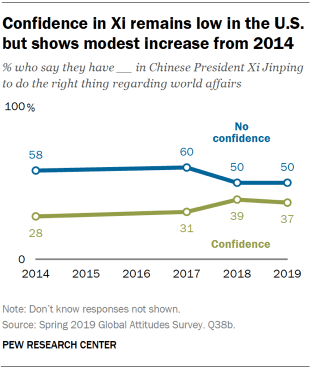Over half of Americans see friction in the current bilateral economic relationship, and more now see China as a threat
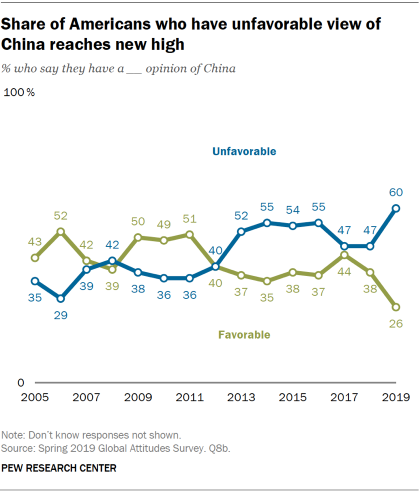 Over the past year, the United States and China have slapped a series of escalating tariffs on one another, with the U.S. now taxing more than $250 billion worth of Chinese goods. Despite periodic, high-level meetings intended to defuse these trade tensions, results of a new Pew Research Center survey indicate Americans believe economic ties between China and the U.S. are poor. And, amid these economic concerns, unfavorable opinions of China have reached a 14-year high. Today, 60% of Americans have an unfavorable opinion of China, up from 47% in 2018 and at the highest level since Pew Research Center began asking the question.
Over the past year, the United States and China have slapped a series of escalating tariffs on one another, with the U.S. now taxing more than $250 billion worth of Chinese goods. Despite periodic, high-level meetings intended to defuse these trade tensions, results of a new Pew Research Center survey indicate Americans believe economic ties between China and the U.S. are poor. And, amid these economic concerns, unfavorable opinions of China have reached a 14-year high. Today, 60% of Americans have an unfavorable opinion of China, up from 47% in 2018 and at the highest level since Pew Research Center began asking the question.
Americans also increasingly see China as a threat. Around a quarter of Americans (24%) name China as the country or group that poses the greatest threat to the U.S. in the future, twice as many as said the same in 2007. China is tied with Russia (24%) as the country or group most cited as a threat to the U.S. The only other country to measure in the double digits is North Korea (12%).
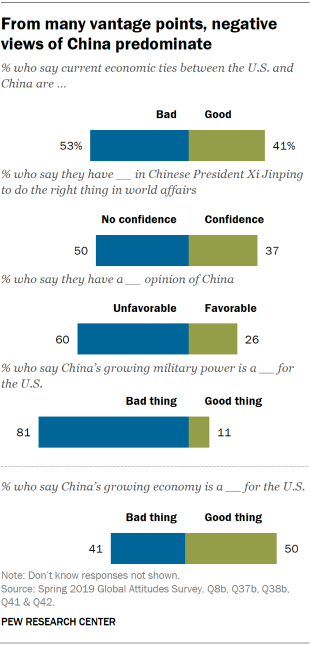 While people are concerned about the current bilateral economic relationship and increasingly see China as a potential adversary, they do not necessarily think China’s growing economy is bad for the United States. More Americans say China’s growing economy is good for the U.S. than that it is bad (50% vs. 41%, respectively). But, when it comes to China’s increasing military strength, opinion is more uniformly critical: 81% of Americans think China’s growing military power is bad for the U.S.
While people are concerned about the current bilateral economic relationship and increasingly see China as a potential adversary, they do not necessarily think China’s growing economy is bad for the United States. More Americans say China’s growing economy is good for the U.S. than that it is bad (50% vs. 41%, respectively). But, when it comes to China’s increasing military strength, opinion is more uniformly critical: 81% of Americans think China’s growing military power is bad for the U.S.
Republicans and Democrats largely agree in their assessments of how China’s growing economy and military will affect the U.S. But, while both Republicans and Democrats have unfavorable views of China, Republicans’ opinions are somewhat more negative: 70% of Republicans and independents who lean Republican have an unfavorable opinion of China today, compared with 59% of Democrats and Democratic-leaning independents.
Partisans also diverge sharply when it comes to the state of current bilateral economic relations as well as their evaluations of which country has the world’s strongest economy. Republicans are more likely to say current economic ties between the United States and China are good, as well as to see the U.S. as the leading global economy. Party affiliation also colors which country or group people consider the most threatening to the U.S.: Republicans are more than twice as likely to name China as they are any other country (32%), while Democrats name China second – behind Russia – as the most threatening country (36% name Russia, 19% China).
The new survey by Pew Research Center, conducted May 13 to June 18, 2019, among 1,503 adults, also finds that older Americans tend to have more negative views of China than younger Americans. Older Americans are also more likely to be concerned about the impact of both China’s growing military and economic strength on the United States, though they are more likely to see the U.S. as the leading economic power than younger Americans.
Unfavorable opinion of China reaches new high
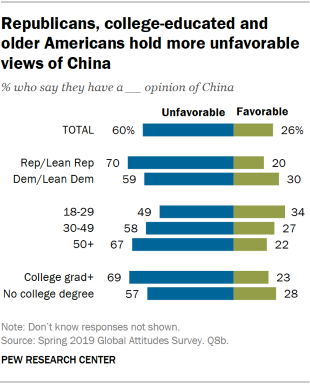 American opinion of China has fluctuated somewhat over time, with positive views outnumbering negative ones during President Barack Obama’s first term in office, but negative views mostly predominating since. Still, unfavorable opinion has never been higher than it is now, based on Pew Research Center’s 14 years of polling on the topic. Today, 60% of Americans have an unfavorable opinion of China, including around a quarter who have a very unfavorable opinion. This 13 percentage point increase in unfavorable opinion from 2018 to 2019 also marks the largest year-on-year change in public opinion toward China since 2005.
American opinion of China has fluctuated somewhat over time, with positive views outnumbering negative ones during President Barack Obama’s first term in office, but negative views mostly predominating since. Still, unfavorable opinion has never been higher than it is now, based on Pew Research Center’s 14 years of polling on the topic. Today, 60% of Americans have an unfavorable opinion of China, including around a quarter who have a very unfavorable opinion. This 13 percentage point increase in unfavorable opinion from 2018 to 2019 also marks the largest year-on-year change in public opinion toward China since 2005.
As has historically been the case in Pew Research Center polling, older people tend to have more negative opinions of China than younger people. About half of 18- to 29-year-olds (49%) express an unfavorable view of China, compared with 58% of those ages 30 to 49 and two-thirds of people 50 and older (67%). People with at least a four-year college degree are also more negative toward China (69%) than those who have not completed college (57%).
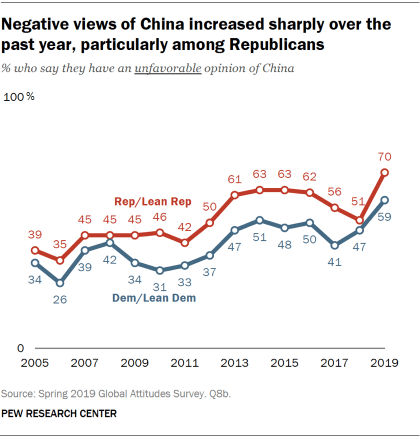 While unfavorable opinion of China increased among partisans of all stripes over the past year, Republicans and Republican-leaning independents have become particularly negative in their evaluations of China. Seven-in-ten Republicans and Republican leaners have an unfavorable opinion of China today, up from 51% in 2018. Among Democrats and Democratic leaners, unfavorable opinion increased somewhat less over the same period, from 47% to 59%.
While unfavorable opinion of China increased among partisans of all stripes over the past year, Republicans and Republican-leaning independents have become particularly negative in their evaluations of China. Seven-in-ten Republicans and Republican leaners have an unfavorable opinion of China today, up from 51% in 2018. Among Democrats and Democratic leaners, unfavorable opinion increased somewhat less over the same period, from 47% to 59%.
More Americans say current U.S.-China economic ties are poor
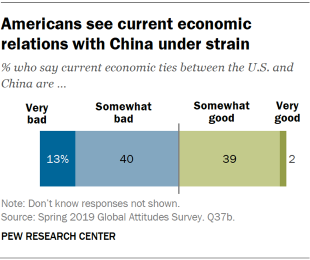 Shifting attitudes toward China are colored, in part, by the context of the continued trade frictions and tariffs between the United States and China. Today, just over half of Americans (53%) believe current economic ties between the U.S. and China are bad. Fewer (41%) think economic relations between the two nations are good, with just 2% of American adults saying ties are verygood. Partisanship is associated with views of the U.S.-China economic relationship: While 49% of Republicans and Republican-leaning independents see current ties as good, around one-third (36%) of Democrats and Democratic-leaning independents share this view. And, despite having more favorable views of China, younger Americans (ages 18 to 29) are about as likely as those 50 and older to have negative views of current economic relations with China (58% and 53%, respectively, say ties are bad).
Shifting attitudes toward China are colored, in part, by the context of the continued trade frictions and tariffs between the United States and China. Today, just over half of Americans (53%) believe current economic ties between the U.S. and China are bad. Fewer (41%) think economic relations between the two nations are good, with just 2% of American adults saying ties are verygood. Partisanship is associated with views of the U.S.-China economic relationship: While 49% of Republicans and Republican-leaning independents see current ties as good, around one-third (36%) of Democrats and Democratic-leaning independents share this view. And, despite having more favorable views of China, younger Americans (ages 18 to 29) are about as likely as those 50 and older to have negative views of current economic relations with China (58% and 53%, respectively, say ties are bad).
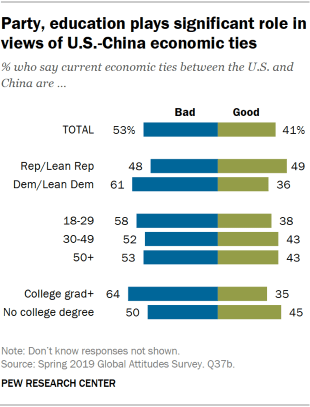 Previous Pew Research Center work on U.S. views of China has shown that Americans often express more concern about China over economy-related issues, such as Chinese-held American debt and job loss to China. The most recent survey again reveals how Americans see China through an economic prism, one that in recent months has been clouded by bellicose discourse around trade disputes. Those in the U.S. who see economic ties with China as bad are much more likely than those who think the nations have good economic ties to have overall unfavorable views of China (71% vs. 47%).
Previous Pew Research Center work on U.S. views of China has shown that Americans often express more concern about China over economy-related issues, such as Chinese-held American debt and job loss to China. The most recent survey again reveals how Americans see China through an economic prism, one that in recent months has been clouded by bellicose discourse around trade disputes. Those in the U.S. who see economic ties with China as bad are much more likely than those who think the nations have good economic ties to have overall unfavorable views of China (71% vs. 47%).
Americans increasingly see China as a threat
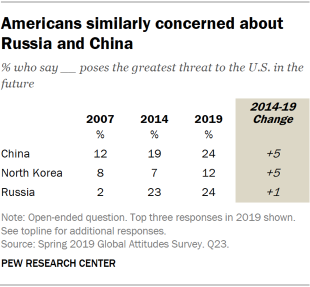 Some elected officials and policymakersincreasingly have been highlighting the ways in which China threatens the United States, even reviving the Committee on the Present Danger. Alongside these high-level shifts, the American public has grown more concerned about China’s future impact on the U.S. When asked to name the country or group that poses the greatest future threat to the U.S., China is one of the two most frequently named entities, with about a quarter of Americans citing the country as the greatest future threat (24%). This is a 5 percentage point increase from 2014, when 19% of Americans considered China to be the U.S.’s greatest future threat, and twice as many as said the same in 2007. Russia is the only other country named with similar frequency; another 24% of Americans consider it the country’s largest future threat this year. While largely unchanged since 2014, this marks a 12-fold increase from 2007. Over this same period, concerns about Iran and Iraq have fallen precipitously (from 24% in 2007 to 6% in 2019 for Iran, 21% to 1% for Iraq).
Some elected officials and policymakersincreasingly have been highlighting the ways in which China threatens the United States, even reviving the Committee on the Present Danger. Alongside these high-level shifts, the American public has grown more concerned about China’s future impact on the U.S. When asked to name the country or group that poses the greatest future threat to the U.S., China is one of the two most frequently named entities, with about a quarter of Americans citing the country as the greatest future threat (24%). This is a 5 percentage point increase from 2014, when 19% of Americans considered China to be the U.S.’s greatest future threat, and twice as many as said the same in 2007. Russia is the only other country named with similar frequency; another 24% of Americans consider it the country’s largest future threat this year. While largely unchanged since 2014, this marks a 12-fold increase from 2007. Over this same period, concerns about Iran and Iraq have fallen precipitously (from 24% in 2007 to 6% in 2019 for Iran, 21% to 1% for Iraq).
In 2019, China and Russia are named twice as often as the third-most mentioned country: 12% of Americans consider North Korea the greatest future threat.
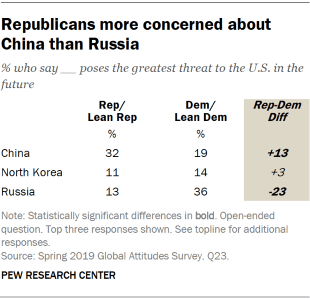 But partisan differences are stark when it comes to concerns about China and Russia. Republicans and Republican-leaning independents (32%) are much more likely than Democrats and Democratic leaners (19%) to name China as the biggest threat to the U.S. in the future. Among Republicans, China is the most frequently named threat in 2019; in comparison, Democrats most frequently cite Russia as the U.S.’s greatest future threat.
But partisan differences are stark when it comes to concerns about China and Russia. Republicans and Republican-leaning independents (32%) are much more likely than Democrats and Democratic leaners (19%) to name China as the biggest threat to the U.S. in the future. Among Republicans, China is the most frequently named threat in 2019; in comparison, Democrats most frequently cite Russia as the U.S.’s greatest future threat.
A separate Pew Research Center survey conducted in July found a similar pattern, with Democrats much more likely than Republicans to view Russia’s power as a major threat to the well-being of the U.S., and Republicans modestly more likely than Democrats to say this about China. There was no partisan difference in in the shares naming China’s influence as the country’s greatest future threat in 2014.
China’s military growth, not economic growth, seen as potential problem for the U.S.
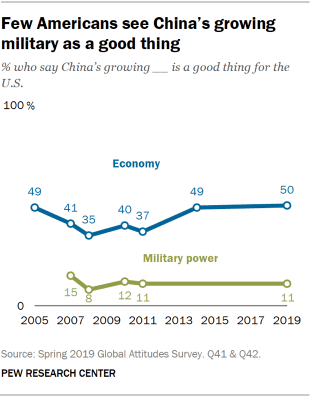 China’s navy and air force are the largest in Asia, and defense spending has risen rapidlyover the past decade. Against this backdrop, a large majority of Americans (81%) say China’s growing military power is a bad thing for the U.S. Only about one-in-ten (11%) say it’s a good thing. Even among those with favorable views of China, roughly seven-in-ten (69%) view its expanding military power negatively. Nationwide, the sense that China’s growing military would be beneficial for the U.S. has remained largely unchanged over the past decade.
China’s navy and air force are the largest in Asia, and defense spending has risen rapidlyover the past decade. Against this backdrop, a large majority of Americans (81%) say China’s growing military power is a bad thing for the U.S. Only about one-in-ten (11%) say it’s a good thing. Even among those with favorable views of China, roughly seven-in-ten (69%) view its expanding military power negatively. Nationwide, the sense that China’s growing military would be beneficial for the U.S. has remained largely unchanged over the past decade.
Across age groups, concern about China’s growing military power is highest among older Americans. Among those ages 50 and older, 84% say it is a bad thing, while 76% of those 18 to 29 say the same. Those with at least a four-year college degree are more likely than those without to view China’s growing military power negatively. There are notably no significant partisan divisions over this issue.
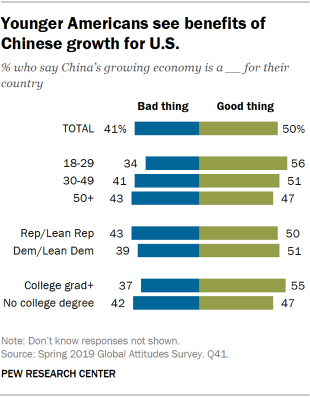 But even while many Americans are concerned about the potential impact of China’s military growth, they are somewhat sanguine about how China’s economic growth affects the United States. Half of Americans think China’s growing economy is a good thing for the U.S. while 41% say it’s a bad thing. When first asked in 2005, similar proportions felt the same (49% good, 40% bad). Such optimism was not always the case, though. Those saying China’s economic achievements were good for America dropped to less than 40% in 2008 and 2011. However, in 2014 these attitudes rebounded slightly.
But even while many Americans are concerned about the potential impact of China’s military growth, they are somewhat sanguine about how China’s economic growth affects the United States. Half of Americans think China’s growing economy is a good thing for the U.S. while 41% say it’s a bad thing. When first asked in 2005, similar proportions felt the same (49% good, 40% bad). Such optimism was not always the case, though. Those saying China’s economic achievements were good for America dropped to less than 40% in 2008 and 2011. However, in 2014 these attitudes rebounded slightly.
Interestingly, roughly half of both Republicans (50%) and Democrats (51%) agree that Chinese growth is good for the U.S. This relative agreement stands in marked contrast to evaluations of the state of current bilateral economic relations, which are colored by partisanship.
Younger Americans – who are more favorable toward China overall – are also more likely than older Americans (56% vs. 47%) to see benefits to China’s growing economy. Those with at least a four-year college degree are also slightly more likely than those without to say China’s growing economy is good for the U.S.
Americans see their own country leading economically
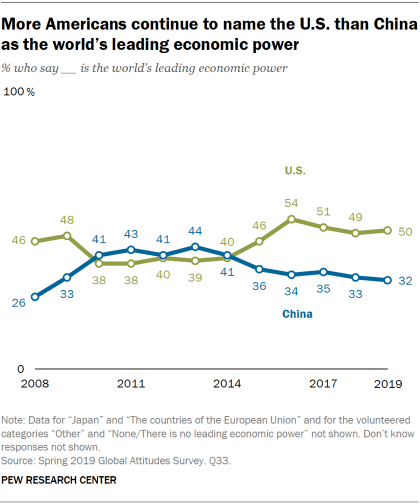 Although China’s economy has grown consistently at above 6% for more than a decade, Americans’ views of which country – China or the U.S. – has the strongest economy have fluctuated considerably over this same period. Since 2015, however, when asked to choose between the U.S., China, Japan and the countries of the European Union as the world’s leading economic power, Americans tend to choose their own country. Today, half of Americans say the U.S. is the dominant economy, whereas roughly one-third (32%) name China – an 18 percentage point difference.
Although China’s economy has grown consistently at above 6% for more than a decade, Americans’ views of which country – China or the U.S. – has the strongest economy have fluctuated considerably over this same period. Since 2015, however, when asked to choose between the U.S., China, Japan and the countries of the European Union as the world’s leading economic power, Americans tend to choose their own country. Today, half of Americans say the U.S. is the dominant economy, whereas roughly one-third (32%) name China – an 18 percentage point difference.
There is a stark partisan difference in how Americans evaluate the world’s top economic power. Republicans and Republican-leaning independents are more than three times as likely to name the U.S. as they are China (67% and 21%, respectively). In contrast, Democrats and Democratic-leaning independents are equally likely to name the U.S. and China (both 40%).
Younger Americans are also more likely than older Americans to say China is the leading economic power: 37% of those ages 18 to 29 name China as the leading economic power, while 27% of those 50 and older do the same. Those who say that China’s growing economy is a bad thing for the U.S. are similarly more likely to say China is the top economic power than those who say the growing economy is a good thing.
 Americans have limited confidence in President Xi
Americans have limited confidence in President Xi
On balance, Chinese President Xi Jinping receives negative ratings from the American public. Half of U.S. adults surveyed say they have little or no confidence in the Chinese leader, while 37% have at least some confidence. This is little changed from 2018but has increased 9 percentage points since the question was first asked in 2014.
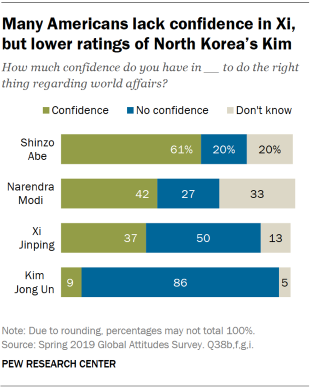 Equal shares of Democrats and Republicans (50%) say they lack confidence in the Chinese president. For Republicans, this marks increased confidence in Xi since 2014, when 65% said they had little to no confidence in him. Democratic confidence in him has remained largely unchanged over the past five years.
Equal shares of Democrats and Republicans (50%) say they lack confidence in the Chinese president. For Republicans, this marks increased confidence in Xi since 2014, when 65% said they had little to no confidence in him. Democratic confidence in him has remained largely unchanged over the past five years.
Fewer Americans voice confidence in Xi than say the same of leaders from other Asian nations, including Japan’s Shinzo Abe (61% confidence) and India’s Narendra Modi (42%). However, many more think Xi will do the right thing regarding world affairs than North Korean leader Kim Jong Un, in whom a mere 9% of Americans have confidence.
To read the full report by the Pew Research Center, please click here.

